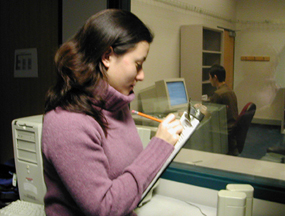
 |
||
 |
 |
 |
 |
||
 |
||
 |
||
 |
||
 |
||
 |
||
 |
||
 |
||
 |
||
 |
||
 |
||
| site credits | ||
Facilities
User Studies Laboratory
| The User Studies Lab (USL) is a multi-room facility for research on human-computer interaction. The lab has been used for dozens of investigations into the usability of new technology and interaction techniques. Computer scientists have studied speech-recognition, command languages, and help systems; psychologists have studied computer-aided instruction and human-robot interaction; faculty in the English Department have studied documentation and collaborative writing; the business school has studied errors in telephone-based interactions and the efficacy of object-oriented programming; and engineers have studied the effects of access to large databases on engineering policy decisions. The USL also is used for training researchers and students to perform "think-aloud," observational, and other empirical usability studies.
The USL has equipment for single-user laboratory and field recording of color video data. The USL is housed in Newell Simon Hall, where it has space to accommodate research into the usability of multi-media, multi-user, multi-location computer systems. One room allows for investigations of the performance of groups of people (e.g., a 12-person design team) as they use networked systems, shared workspaces, and other computer-mediated group-support tools. Combinations of rooms allow researchers to study communications among between local and remote groups, using technologies including wireless networks, personal digital assistants, video communications, or wearable computers. Video, audio, and data-analysis software and equipment are available for collecting and analyzing data. An ISCAN eye-tracker is integrated into one of the lab rooms. |
 Observing from the control room The eye-tracking set up |
Interactive Systems Laboratory
The Interactive Systems Laboratory (ISL) at Carnegie Mellon is associated with School of Computer Science. ISL currently has five faculty members and twenty graduate students and research staff carrying research activity in the areas of human computer interaction and language technology. The ISL has all necessary components for integrating a multimodal interface—including writing, pointing, speaking, gesturing to provide rapid information access, manipulation and dissemination—in a flexible way. The individual modalities are processed by state-of-the-art recognition systems that can operate at high accuracy and accept continuous (open) microphone, pen, or visual input. State-of-the-art systems have been developed and/or can be accessed, which include:
- JANUS (speech recognition system) is a large vocabulary continuous-speech speaker-independent recognition system. It has been ranked at top in many recent evaluations in both US and Europe. The system can handle both dictation and conversation.
- NPen++ (handwritten character recognizer) delivers 94% writer-independent correct recognition over a 20,000 word vocabulary (without the help of language model). It runs under the same environment as our speech recognizer, thereby facilitating integration.
- A stroke-based gesture recognizer.
- Real-time visual tracking systems (face tracking, gaze tracking, people tracking), self-contained, without using any specialized hardware.
- A high performance continuous spelling recognizer for large lists of names (100,000+).
Hardware resources include an intelligent meeting room equipped with smartboard, projectors, microphones, and cameras, over 40 PCs, 15 Sun workstations, 10 video cameras, 2 omnidirectional camera, 13 CCD high resolution camera, and various types of microphones. These resources are located in an air-conditioned suite of about 1200 sq. ft. in Newell-Simon Hall, Carnegie Mellon University.
This work is funded by the National Science Foundation, grant #0208903. The opinions and findings expressed on this site are those of the investigators, and do not reflect the views of the National Science Foundation.